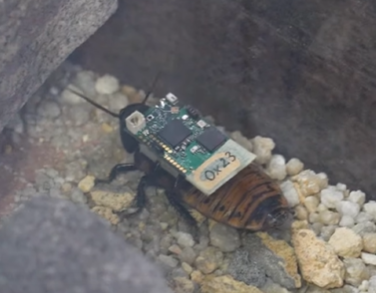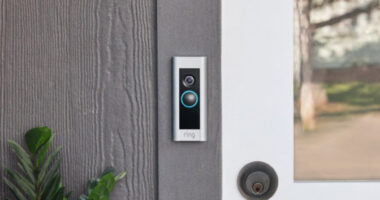A CLEVER team of scientists have created a set of cyborg cockroaches with robot brains specially trained to save lives.
The fascinating invention will see the insects deployed after natural disasters to crawl inside tiny gaps and send their human handler vital information about the whereabouts of survivors.
Stuck on the back of real-life Madagascan hissing cockroaches, the technology sits on a panel that uses an infrared camera and a series of sensors to collect and send data to first responders.
Electrodes are implanted on top of the bug’s nervous system and can be seamlessly controlled by a human in a safe zone.
Dubbed “a bug backpack” the sensors, battery and camera all weigh less than six grams meaning it can easily be carried by the cockroach.
The insect can swiftly move in and out of small spaces meaning the time it takes to identify survivors trapped under rubble should be rapidly shortened.
read more in clever tech
Once the technology spots a body, it alerts their handler who sends the information and a location across to emergency services who can start the rescue mission.
The cyborgs also use a minimal amount of power on each run compared with miniaturised robots that are currently being modelled.
The latest prototypes can operate for up to eight hours using batteries but it is hoped that the scientists can develop a system where they harvest energy from the sun top make them last even longer.
So far, 10 of the 6cm hybrid cockroaches have been tested for the world to see.
Most read in Tech
Tests saw the group of roaches crawling in and out of tiny gaps within a large pile of simulated rubble – similar to the aftermath of an earthquake.
The cyborg bugs are being developed in Singapore by the Home Team Science and Technology Agency and Nanyang Technological University.
Klass Engineering and Solutions are also apart of the team.
The original idea for the hero insects comes from Professor Hirotaka Sato.
He witnessed the devastation caused by the 2011 Japanese earthquake first-hand and quickly realised there needed to be a faster and more effective way of finding survivors and victims.
He said: “Our motivation is purely to use this technology for search and rescue. To save people from disaster.”
Sato and his clever team managed to figure out how they could remotely steer the insects so they can travel left, right or forwards at the push of a button.
They can also move on their own using autonomous navigational technology.
The bugs were first showcased at the Milipol Asia-Pacific and TechX Summit at the Sands Expo and Convention Centre in early April.
Many rescue teams across the world currently use sniffer dogs to try and find survivors but the canines can’t always pinpoint exact spots where people are trapped as they can’t venture inside the rubble.
Sato hopes his invention will be up and running in disaster zones in the next three to five years.
It comes as scientists in China have also created a battery system that can be implanted into the human body and continuously produce electricity.
The ground-breaking design from the experts at China’s Tianjin University of Technology is set to revolutionise the health industry.
Similar to pacemakers and neurostimulators, these new batteries will have an infinite source of life – oxygen.
READ MORE SUN STORIES
The breakthrough follows ground-breaking developments in brain chips – such as Elon Musk’s Neuralink, which hopes to restore autonomy to those with medical needs.
A 29-year-old quadriplegic, Noland Arbaugh, was the “first-ever user of the Neuralink device” when he got it implanted in March.
















